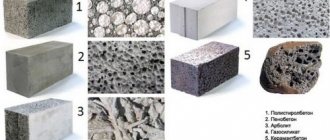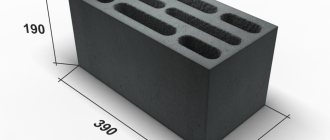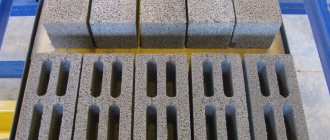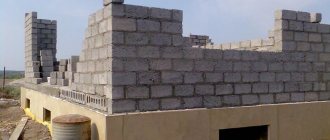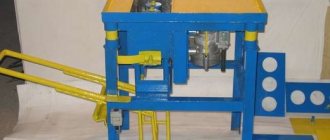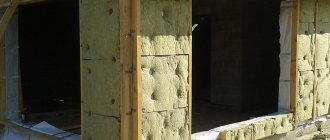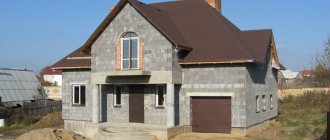Kalita LLC offers high-quality partition blocks made of expanded clay concrete.
This is a modern building material with which you can solve various problems. Such blocks are widely used in the construction of buildings and structures for various purposes. They can be either hollow or solid.
Hollow blocks are used for the construction of internal interior partitions during the construction of both low-rise and high-rise buildings. Their solid counterparts can be used both to create interior partitions and to make dividing partitions in a wide variety of rooms:
- workshops; garages; production workshops; warehouse and administrative buildings.
The blocks can subsequently be decorated with any types of facing materials. Their ideal geometry greatly simplifies installation. With their help, you can quickly erect partitions of the required thickness.
Partition blocks made of expanded clay concrete: material characteristics
Expanded clay concrete is widely used in modern construction due to its outstanding performance characteristics.
Blocks made from it provide good vapor permeability, which ensures a comfortable level of humidity in the room. This building material is not afraid of frost and can withstand sudden temperature changes. Expanded clay concrete partition blocks are characterized by excellent resistance to high humidity.
It is important to note that in many respects this building material turns out to be more profitable than the more common concrete and brick. An expanded clay concrete block is comparable in size to several bricks, which makes it possible to carry out construction at a faster pace. At the same time, it is relatively light, so there is no need to lay a solid and very expensive foundation (if we are talking about low-rise construction).
Any expanded clay concrete blocks, including partition walls, are easy to process. Therefore, if necessary, they can be adjusted to the required dimensions with minimal time.
Finally, an important advantage of expanded clay concrete blocks is their environmental friendliness. For the manufacture of this building material, the following raw materials are used:
- expanded clay; cement; sand; water.
That is, each block consists only of environmentally friendly raw materials, completely harmless to human health. In many countries, it is precisely for this reason (not to mention convenience, practicality and relatively low cost) that expanded clay concrete is especially widely used for housing construction.
The next advantage that blocks made of this material have is their outstanding sound and heat insulation properties. This not only guarantees incredible comfort, but also reduces costs for insulating materials and heating.
What are the advantages of expanded clay concrete
Partitions made from expanded clay concrete hollow blocks have a number of advantages related to the characteristics of the material from which they are made:
- This material is noticeably lighter than concrete (has a lower volumetric weight), which greatly facilitates the installation of structures based on it.
- In terms of mechanical strength, such blocks are comparable to their concrete counterparts, and are not inferior to them in terms of resistance to cracking.
- The use of expanded clay concrete is justified by its fire resistance (with strong heating, the load-bearing capacity of the products does not decrease).
- Buildings made from such blocks are distinguished by good vapor permeability (the wall of them “breathes” to its entire depth).
Important: Expanded clay concrete has excellent heat-insulating and sound-absorbing properties.
- Products made from it are distinguished by enviable frost resistance and can withstand about 100 cyclic freezing followed by thawing.
- The environmental friendliness and low cost of expanded clay concrete blanks are especially in demand in the construction of residential building structures.
It is also important that hollow expanded clay concrete partition blocks can be made directly on the construction site (for this, simple equipment will need to be installed next to the object being built).
Builders note their good adhesion to most finishing materials, including ceramic tiles, laminated plastic, plaster or natural wood.
Buy partition blocks from our company
Types of products, their characteristics, price - all this is indicated in the price list on our website. If you have any questions, be sure to ask our managers: they will answer them clearly, reasonably, and advise on the purchase, delivery, and operation of units.
For production, effective modern semi-dry pressing technology is used. Due to strict adherence to the conditions of the production process, the blocks fully comply with the requirements of GOST 6133-99. Strict control of finished products also helps improve quality.
The blocks that you can buy from Kalita LLC are stacked on pallets, which greatly simplifies their loading, transportation, unloading and storage, as well as accounting.
The number of units on a pallet depends on the specific product category. From us you can purchase both solid and hollow expanded clay concrete blocks of various sizes. Thanks to a wide selection of building materials, you can implement any construction plans.
In our warehouse you will always find a sufficient number of blocks for the construction of partitions.
With their help, you can build reliable, durable, durable buildings and structures. This unit is excellent for use in Russia; it tolerates almost any climatic conditions. Contact us for high-quality modern materials!
Back
- Date: 05/18/2015 Comments: Rating: 33
The use of expanded clay concrete blocks is a relatively recent experience, since the material is considered relatively new in the construction industry. The base of the products is concrete mixed with fusible clay, represented by granules.
Diagram of the structure of an expanded clay concrete block.
Tongue-and-groove wall panels
In construction practice, in the manufacture of expanded clay concrete partitions, tongue-and-groove panels are increasingly used, which significantly facilitate the installation of structures and reduce the consumption of mortar (glue). One such panel with a height of 2.5 meters is equal in area to approximately 20 medium-sized blocks.
Therefore, it will be very difficult for one person to cope with them (an assistant will be required). Due to the large area covered by one panel, the speed of assembly operations increases significantly. At the same time, the quality of the finished partition does not suffer at all, and in any case remains high.
In conclusion, we note that the production of expanded clay concrete blocks has been mastered in many cities of Russia (including several enterprises located in Moscow). Anyone wishing to get acquainted with the prices of expanded clay concrete products can contact the website of the organization selling them.
Features of using expanded clay concrete blocks
This material is actively used in the construction of walls of buildings whose height is equal to one or two floors.
These products are so popular due to the fact that they have low weight and excellent thermal insulation characteristics. Such features of expanded clay concrete blocks make it possible to provide a less significant load on the base of the foundation. The presence of voids in the blocks allows for the reinforcement of walls, making them more resistant to external influences and destruction.
Scheme of a partition made of expanded clay concrete.
Partitions can be erected using this material much faster than using brick, since the material has significant dimensions. After the partition is erected, the surface of the new walls can be refined with a putty mixture, which will prepare the wall for further wallpapering. Expanded clay concrete blocks are environmentally friendly, since they contain only natural raw materials, and during operation the walls will not undergo rotting processes and will not ignite when exposed to fire.
Craftsmen are increasingly choosing this material for the construction of partitions, since the blocks are quite easy to saw, which is required when adjusting the dimensions. If necessary, you can drive a nail into such a wall, which will be needed when installing the sink. Expanded clay concrete blocks are available in two sizes, the first of them: 90x190x188 mm, such products are used for laying walls, while products with dimensions equal to 390x190x90 mm are used in the construction of partitions.
Return to contents
If the partitions are built at the time of construction of the house, then the installation will have to be carried out on the foundation, the surface of which should first be protected with waterproofing material. To do this, it is recommended to use rolled roofing felt, folded in half. It must be covered with a thin layer of cement mortar.
In order to ensure the evenness of the row, it is necessary to use a fishing line stretched level, which can be replaced with thread or cord. The fishing line should be pulled at a level whose width is equal to the thickness of the block with a layer of solution.
Adhesive cement is used as a masonry composition. To determine the horizontal position of the blocks, use a laser level. If these blocks are also used to lay the walls of the building, work must begin from the corner, using a plumb line to align the products vertically.
If the work is carried out using the butting method, where the thickness of the block is equivalent to the thickness of the wall, which is 200 mm, then vertical ligation of the seams should be taken as a basis.
Tools for laying walls made of expanded clay concrete blocks.
After construction, the external walls will be thin, which suggests the need for insulation.
Due to the fact that the blocks have a ridge locking system, when laying partitions, the vertical joints do not need to be filled with mortar, since no grooves or through gaps will be formed in the space. The seams that are formed between rows horizontally should not be more than 10 cm. The main feature of expanded clay concrete blocks is the need for simultaneous construction of load-bearing walls and internal partitions.
The partition must be additionally strengthened, for which it is recommended to use mesh or reinforcement, while standard lintels can be replaced with two corners, which should be mounted on the edges of the products with a support of 10 cm on each side.
To carry out the work, it is necessary to prepare the following materials and tools:
- corners; glue-cement; laser level; container; drill with a mixer attachment; mesh.
Types of expanded clay concrete blocks.
The mortar that was laid on the blocks must be ground until the layer is uniform, and a new product should be used, not a trowel.
The next block must be mounted edge to edge of the product laid in a row; this must be done at some distance. The expanded clay concrete block must be brought to the final location so that its edge collects a certain amount of adhesive for the seam vertically.
To build partitions, you can independently make blocks, which should include: cement, expanded clay and sand. Before mixing the ingredients, it is necessary to prepare the formwork. However, it should be taken into account that to carry out the process you will need to rent special equipment in the form of a vibrating table.
Due to the fact that the described blocks are large in size compared to bricks, it will be possible to save money when carrying out work on the construction of partitions by using glue. Thus, the amount of adhesive mixture will be approximately 30-40 kg per 1 m3.
Seams should be formed before the glue hardens.
The reinforcement is laid in every 2-3 rows.
The mesh should be mounted on the top row; it should be placed in the grooves, applying a solution on top, which will allow the formation of the next row. When arranging spoon and butt rows, they must be bandaged. If there is to be an opening in the partition, it must be strengthened using a U-shaped block made of concrete and reinforcement.
Masonry can also be carried out using ordinary mortar, for the preparation of which a container is useful; stirring must be done with a construction mixer. The solution must be prepared using a 1:4 ratio of cement and sand as a basis; water must be added until the solution has the consistency of batter.
The construction of partitions based on expanded clay concrete blocks is carried out using the same technology that is used when arranging masonry from ordinary bricks. However, it will be possible to complete the work in a shorter time, and in addition, you will be able to save money.
12.04.2018
For more than half a century, laying walls from expanded clay concrete blocks has been extremely popular among private developers. This building material is used to build utility rooms, garages, and permanent houses. The correctness of the choice is confirmed by the experience of hundreds and thousands of people who have acquired country estates.
A house made of expanded clay will be beautiful, warm and cozy
Selection of expanded clay concrete
When purchasing products, you should pay attention to certain points, the main place among which is given to the process of careful visual inspection of the blocks:
- Color . The standard color of artificial stone is gray or dark gray. If it has a yellowish tint, it means that the technology for its production was violated, and more quartz sand was added than necessary, which means that the strength and density characteristics were violated. There should also be no dark or white spots on the surface.
- Geometry . If the stone samples have different parameters, then difficulties may arise during their laying. Attention is also paid to the edges and condition of the corners. They should be uniform and not chipped.
- Surface quality . The blocks may be rough or smooth, but without splits or damage.
- Product weight . Mandatory requirement for every product. Several samples are compared with each other. Only a small error in grams is acceptable, but not much difference.
- Manufacturer. The best domestic factories for the production of expanded clay concrete products are considered to be:
- Cheboksary "Stroykombinat"
- TPA Unite LLC (MO).
- LLC "Keramzit" (Tula).
- Concrete.
- CJSC "Keramzit" (Ryazan).
Also, much attention is paid to the labeling specified by the manufacturer. Pay attention to the indicators:
- M - cement composition based on density saturation.
- B - strength characteristics.
- P - septal - an important designation of the product.
Advantages and disadvantages
Mansions made of expanded clay concrete blocks have many advantages.
The light weight and fairly regular geometric shapes of the elements make working with them extremely simple.
And laying expanded clay concrete blocks with your own hands significantly reduces the final cost of the finished house. The lightness of expanded clay concrete blocks allows you to lay a less solid foundation. Which again affects the price of a dacha or garage towards its reduction. The environmental friendliness of expanded clay concrete blocks is also highly valued: the material contains only sand, water, cement and expanded clay. Unlike, for example, aerated concrete blocks, expanded clay concrete does not contain any chemical additives or surfactants. Blocks made from this material have high thermal insulation characteristics, which allows the use of expanded clay concrete even in harsh climatic conditions. The strength of expanded clay concrete blocks is also quite high.
Some grades of material can be used to build a building up to three floors high. A building built from expanded clay concrete blocks is very durable. Increased frost resistance combined with extremely low water absorption will ensure decades of operation without the need for major repairs. Expanded clay blocks are an excellent sound insulator. So this material is recommended for use by those whose site is located near major roads or railway lines. The blocks have high resistance to fire, aggressive environments and bacterial influences.
If you give preference to laying expanded clay concrete blocks, the process will go faster due to the size of the fragments.
So the house will be built much earlier than a similar brick building. And you will have to buy less material individually: one block is equal in volume to seven bricks. In addition, expanded clay blocks are significantly cheaper than traditional materials.
But expanded clay concrete blocks cannot be called perfect. Blocks also have disadvantages.
- The porosity of the material reduces its physical and mechanical qualities compared to heavy grade concrete. The appearance of expanded clay blocks is quite unpresentable. In this regard, the masonry of expanded clay concrete blocks will have to be finished both outside and inside. Compared to brickwork, a wall made of expanded clay concrete “breathes” less well.
Developers, however, believe that the advantages of the material are much greater than the disadvantages.
Expanded clay concrete blocks are produced in a large assortment
Suitable types for interior walls
For partitions, products with a smooth or rough surface with standard dimensions are used - 200(400)x100x200 mm +(-) 50 mm.
There are also materials 390x190x80 (90) mm, which are installed depending on class B, according to GOST tables, as well as the cement grades used (M400, 500).
In addition to the listed standards, expanded clay concrete half-blocks with dimensions 90 (120) x 188 x 390 mm are also suitable for partitions. These products are needed in order to facilitate the construction process, and there was no need for constant cutting of a normal standard block during laying.
Since the installation of products uses a brick-type laying technique, this greatly simplifies the work process. Semi-blocks are front and row .
Each expanded clay concrete block has its own technical characteristics and markings, which must be indicated by the manufacturer on the manufactured product, made on the basis of such natural components as:
- cement (Portland cement);
- sifted expanded clay or quartz sand;
- granulated carbon clay obtained by firing;
- pure water;
- bitumen emulsion (additional component, acts as a polymer).
For the construction of partitions, manufacturers mark the blocks with the letter “P”. The wall thickness according to technological standards is always 90 mm . The composition of the septum block can vary by brand, determined by the amount of incoming substances.
Many experts use a marking table, the elements of which are presented in the photo:
Types of expanded clay concrete blocks
The manufacturer of this building material can produce elements of different sizes and any shape. However, consumers prefer to use rectangular blocks - and companies take into account the tastes of buyers.
There are three popular block sizes.
- Wall elements are produced either with dimensions 390x300x188, or with dimensions 390x190x188 mm. Such parameters are most optimal for work. The blocks for partitions are thinner - 390x190x90 mm.
In addition, expanded clay blocks can be solid or hollow.
The cavities in the latter are made in different ways: in the form of cylinders, rectangles or slits (large or small). As for solid blocks, they are characterized by increased strength, but are somewhat inferior to their hollow “brothers” in terms of thermal insulation qualities. Some types of solid blocks are produced with grooves made for reinforcement.
Flaws
Construction of a country house
All building materials have their advantages and disadvantages. Expanded clay blocks are no exception and have their own disadvantages that must be taken into account when building a house:
- Increased costs for foundation preparation. Since the density of expanded clay concrete is greater than that of similar cellular concrete blocks, the foundation must be made more massive, designed for a larger load
- The presence of so-called “cold bridges”.
- Limited material strength. The presence of a large number of voids in the structure leads to a decrease in the strength of expanded clay concrete blocks.
Block laying options
There are several methods by which walls can be built. It all depends on the purpose of the building under construction and the requirements placed on it. In particular, it is important to determine the thickness of the walls in advance.
Laying blocks in the box of a building whose walls are as thick as the width of the block.
The method is considered ideal for equipping warehouses, garages or barns. The internal surfaces of the walls are sealed with plaster mixtures, the external surfaces are covered with any insulating material. Most often, either mineral wool or polystyrene foam is used. Walls are laid with a thickness corresponding to the length of the block.
Recommended for the construction of small, frequently used buildings (baths, for example). The installation principles are the same, only the insulation layer is laid out thinner. Laying the blocks into the wall with parallel bandaging of the elements and an air gap between them. With this method of construction, the thickness of the walls will be 60 cm.
The insulation is laid in layers, and the inside of the room is plastered. The technique is used in the construction of summer cottages. Laying two parallel walls at a short distance from one another. The walls are reinforced with reinforcement, and insulating material is laid in the pier.
The last technique is the most difficult. However, its use provides a permanent structure with high thermal insulation characteristics, in which you can live all year round.
The quality of the entire house directly depends on the laying of the first row of blocks.
Construction Features
Anyone who wants to build a house from expanded clay blocks should know the intricacies of the technology of such masonry.
First, you need to decide on the type of material used. For low-rise construction, structural and thermal insulation blocks (density from 700 to 1200 kg/m3) are optimal. Lighter ones are suitable only for insulation, while heavier ones (structural) are used in multi-story construction.
Secondly, choose the block size wisely. In order for the costs of insulating expanded clay walls to be minimal, their thickness must be at least 40 cm (for central Russia). The most popular size used for load-bearing walls is 190x188x390 mm. For self-supporting partitions, blocks with a thickness of 90-120 mm are purchased.
Thirdly, keep in mind that the foundation for the walls must be strong and deep enough. The depth of the trench is chosen based on local soil conditions, but do not dig it shallower than 1.0 -1.2 meters. A sand cushion compacted with a tamper (20 cm thick) under the foundation is required. In addition, you will have to pour a reinforced concrete belt (15-20 cm), making a frame for it from 4-6 reinforcing bars with a diameter of 16-20 mm. In case of uneven soil settlement, it will protect the foundation and walls from cracks.
Fourthly, it is more economically profitable when the insulation and finishing of a house made of expanded clay blocks are carried out simultaneously. Therefore, you should decide in advance on the cladding material (siding, facing brick, facade plaster, blockhouse) and insulation (basalt or ecowool).
The laying of expanded clay blocks is not fundamentally different from the technology for constructing walls made of block aerated concrete. Here, the seams are also bandaged and the deviation of the wall surface from the vertical is monitored (using a plumb line and level). Horizontal evenness is achieved by installing a mooring cord at the corners, marking the line of the row.
When building from expanded clay concrete blocks, there is one important nuance - the use of insulating jute tape. It is laid in the middle of the masonry, thereby cutting off access to the cold through the solution into the premises.
You can save money by abandoning this decision, but in this case, heat will escape from the house through thick masonry joints (12-15 mm).
Another significant aspect of the technology is the reinforcement of masonry. It should be done in 3-4 rows, placing two reinforcement bars with a diameter of 12 - 14 mm in special grooves on the block.
Scheme of reinforcement of masonry made of expanded clay blocksDespite the fact that expanded clay concrete is stronger than aerated concrete, for the installation of floor panels, a monolithic reinforced belt will also have to be made for it. It will distribute the load from the slabs and prevent them from pushing through individual sections of the walls. From the outside, cold reinforced concrete must be insulated using foam inserts 5 cm thick.
As we have already said, laying expanded clay concrete stone is not too complicated, so not only a professional builder, but also any careful beginner can do it if desired. The main condition for quality when working independently is a careful study of the orders (block layout diagrams) and the use of control tools - a plumb line, a level and a mooring cord.
Since the blocks are quite large in size, it is not difficult to lay them out in an even row. The holes made in them increase the accuracy of splitting with a hammer when it is necessary to make a “half” or “three-four” for ligating seams.
Expanded clay concrete blocks drill well and hold fasteners and plaster perfectly. Therefore, installing a ventilated facade on them, finishing with decorative mortar, plasterboard and other sheet materials is not particularly difficult.
Having ordered a detailed project of such a house, most home craftsmen will be able to remove the masonry with their own hands.
Speaking about reviews from people living in buildings made of expanded clay blocks, it should be noted that most of them are positive. Most often, owners note the good heat-saving qualities of the material, its strength and comfortable microclimate in the premises (subject to competently executed masonry and finishing).
Basics of laying expanded clay concrete blocks
The main construction techniques when working with this material are similar to those used when laying bricks. But there are also features that should be taken into account.
- The foundation, filled with mortar, after it has completely set, must be covered with horizontal waterproofing. The masonry is checked using a level after each row. The elements are not particularly flat, so without a level the wall can “lead”. The blocks are always laid from the corner. After every 3-4 rows, reinforcement is carried out. At the end of the masonry, a common reinforcement belt is installed.
Please note that the entire structure made of expanded clay concrete blocks must be erected simultaneously. According to the technology, internal partitions are mounted in parallel with the masonry of load-bearing walls. This is necessary to ensure that all structural elements are strengthened with reinforcement at the same level.
Laying blocks always starts from the corner
Monolithic partitions
Monolithic expanded clay concrete partitions are made using standard technology, according to which the pre-prepared mixture is poured into a mold made of special formwork. To obtain the required quality of the external and internal surface, metal fences are added on both sides.
This type of expanded clay concrete products has both disadvantages and certain advantages. Their disadvantage is that production requires bulky formwork, labor-intensive to manufacture and requiring a large number of one-time operations.
Their advantages include the ability to set arbitrary shapes and dimensions during manufacturing that correspond to the structure being built. In addition, monolithic partitions are more durable (compared to a structure made from single blocks).
Please note: To increase the strength characteristics of expanded clay concrete products, their additional reinforcement using known methods is allowed.
Despite all the listed advantages, these types of partitions are used extremely rarely in practice.
Masonry mortar
As when working with brick, you can use ready-made mixtures. However, the experience of developers shows that a solution prepared independently is no worse, and is many times cheaper. The recipe for the mixture is as follows.
1 part cement.
For laying expanded clay concrete blocks, a portion of sand of at least grade M400.3 is required. Quarry is usually used; if you consider it necessary to increase the elasticity of the solution, replace this component with river sand. 1 part of water. It needs to be added in portions, since the required volume may be less than the calculated one: the presence of natural moisture in the sand affects it.
The finished mixture should not be liquid, but must have sufficient plasticity, which will make it possible to place the block in the desired position.
Reinforcement must be carried out
Installation of a partition made of expanded clay blocks
Mortar for expanded clay concrete
For laying expanded clay concrete blocks, either purchased powder mixtures or solutions prepared independently before starting work are used. In the first case, when mixing them, you should follow the instructions given on the packaging.
Please note: A concrete mixer located close to the place where the partitions are laid is best suited for these purposes.
The basis of home-made solutions is cement of the highest grade (not lower than M400), to which sand, cleared of lumps and debris, is added in the required proportion. The choice of the ratio of components in the solution depends on the required strength of the masonry (under normal conditions it is selected 1 to 3).
The cold water used in the mixture is pre-filtered (cleansed of large particles of debris) before use. Its content in the finished mixture should not exceed 25 percent of the total mass.
When preparing the solution yourself, experts advise adhering to the following rules:
- The composition is prepared immediately before use (due to the possibility of it hardening).
- To do this, it is more convenient to use a small volume concrete mixer.
- First, a little water is poured into it, and then the amount of sand and concrete calculated for one batch is poured.
After the composition is thoroughly mixed, the remaining portion of water is added to it.
Preparing the base
Before laying expanded clay concrete partition blocks, a base is prepared, which means a waterproofing layer laid over concrete. For these purposes the following can be used:
- ordinary roofing felt;
- stekloizol;
- any other laid roll material.
Before laying the insulation, the work area should be cleared of debris and remnants of the old coating, and then leveled with a layer of screed. After this, a layer of cement mortar is applied to the concrete, on top of which waterproofing is laid.
If it is necessary to equip a base for a partition, bricks or FSB are used as a base.
How to lay expanded clay blocks correctly
Before starting installation, you should prepare a set of blanks of already adjusted size and place them next to the work site. After this, you will need to choose a masonry scheme: half or one block (when constructing partitions, the second option is usually used).
The technology for laying expanded clay concrete blanks involves the following sequence of actions:
- First, corner (beacon) blocks are installed.
- Then a string is stretched between them to control the correctness of the masonry.
- After this, be sure to lay the first row of blocks on the mortar (not glue!).
Important! You should start from the highest point of the base, leveling the voids by increasing the width of the gap (seam).
- The second and subsequent rows are laid with a slight offset, and the thickness of the seam should be at least 1 cm.
Upon completion of the next row, it is necessary to check the evenness of the laying, since due to uneven sizes of the blocks it may be disrupted. We should not forget about the reinforcement of the structure, which should be done with a special mesh every 3-4 rows.
Dressing
When installing blocks, first of all you should worry about the connection of the partition with the supporting structures of the building, which is carried out over the entire thickness of the walls. To organize it, holes are drilled into them, into which reinforcing bars are then inserted along with the mortar.
When laying expanded clay concrete partitions and piers, ligation between rows is required, ensured by shifting the blocks in each row by half their length. With a standard size of a typical block blank of 38 cm, this will be approximately 19 cm.
Bandaging allows you to increase the strength of expanded clay concrete structures by distributing the load evenly over their entire area. This method has always been used to reinforce not only light partitions, but also other building structures.
Doorway
When constructing expanded clay concrete partitions, it is necessary to build in door blocks, for the design of which it is advisable to use tongue-and-groove panels. If available, you will need to perform the following operations:
- Securely fasten the side walls, for which a reinforcing rod is used, laid in niches on the sides of the opening.
- Then their sections are filled with a solution, on top of which a pre-prepared metal jumper is laid.
Additional information: For solid expanded clay concrete blanks, reinforcement is not necessary; It’s enough just to align their edges.
For hollow blocks, special jumpers are provided that fit perfectly with them and are hidden in the structure of the pier.
Completion of wall construction
Upon completion of the construction of the expanded clay concrete wall partition, it is not built right up to the ceiling. Between the ceiling and the top row of blocks it is necessary to leave a gap of about 1-1.5 cm (this gap is subsequently filled with polyurethane foam).
The working gap is necessary in order to prevent deformation of expanded clay concrete partitions due to possible vibrations of the ceilings.
Step-by-step instruction
So, the foundation is poured and covered with bitumen material (most often developers prefer to use roofing felt) in at least two layers. Now you can begin building the box, the technology of which consists of the following steps.
In the blocks that will be laid in 3-4 rows, gutters are sawn through for the reinforcement (if you bought building material without grooves already made). In the corners of the building, reference “columns” are laid out, 2-3 elements high, from which laying will be carried out. Between string or fishing line is stretched at the corners to mark the walls. The first row of blocks is laid out on a layer of mortar 1 to 3 cm thick.
A thinner layer can disrupt the geometry of the building being constructed; too thick a layer will lead to severe freezing of the walls in cold weather. Each block is pressed firmly against the base and tapped with a rubber hammer. Don't forget to apply the solution to the joining sides as well.
The excess mixture is immediately removed, and the seam is embroidered before the mortar hardens. After the first row of the external contour is laid out in accordance with the house diagram, the first rows of partitions are laid. All subsequent rows are laid out in the same way, with constant control of verticality using a building level. In each 3- In the 5th row of all walls, both load-bearing and internal, reinforcement is laid in the grooves before laying the next one. For reinforcement, rods with a cross section of 8-10 mm are used. In the case when the installation is not carried out using the well method, the rod reinforcement can be replaced with a mesh, cut into fragments of appropriate sizes and fixed with a solution.
All walls are laid out in this way, checking for compliance with the plan and making window and door openings.
Final: construction of an armored belt
Production technology
Expanded clay is added to the solution at the end.
The basis of the material is: cement (M400, M500), sand, expanded clay (foamed clay baked in an oven), plasticizers. For hollow stones, fractions of 5–10 mm are used, for solid ones—10–20 mm. Proportions and recipes determine the final, clearly defined characteristics of the product. Before pouring, the components of the mixture are thoroughly mixed, expanded clay is added last. The technology involves standard molding and vibratory compaction of the mixture in matrices.
Hollow products are created by timely introduction of void formers into the molds. The goal is to ensure anisotropic properties throughout the volume of the stone. Then the workpieces are steamed and dried. Factory-produced molds ensure the geometric shape of the blocks is identical. The initial set of material characteristics is up to 14 days.
Return to contents
Cost of solid material
Currently, construction hypermarkets offer a wide variety of solid expanded clay concrete blocks. Particularly popular are models with a density of 1500 kg/m3. The cost of one unit of block will cost 50 rubles, while a cubic meter will cost about 3.6 thousand rubles. For this money, the client receives 20 kg of a high-quality product with frost resistance class F50.
When the density is reduced to 1 thousand kg per cubic meter, the mass of the block is reduced to 17 kilograms. At the same time, the indicators of resistance to low temperatures remain the same, and the price increases to 66 rubles per unit and 4158 rubles per cubic meter. Blocks with a density of 700 kg/m3 are also used for construction purposes. This option costs 65 rubles per piece or 4 thousand per cubic meter.
Before starting the construction of a future building or wall structure, you need not only to understand the size and number of blocks, but also to calculate the consumption of mortar for masonry work. Only after careful preparation can you go to the hypermarket and buy the required materials. In this case, the upcoming work will be successful and costs will be minimal.
More about laying corners from expanded clay blocks.
